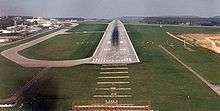Transport in Luxembourg
Transport in Luxembourg is ensured principally by road, rail and air. There are also services along the River Moselle which forms the border with Germany. The road network has been significantly modernised in recent years with motorways to adjacent countries. The advent of the high-speed TGV link to Paris has led to renovation of the city's railway station while a new passenger terminal at Luxembourg Airport has recently been opened. There are plans to introduce trams in the capital and light-rail lines in adjacent areas.

Railways
Operated by Chemins de Fer Luxembourgeois (CFL), Luxembourg's railways form the backbone of the country's public transport network, linking the most important towns. The total length of operational (standard gauge) track is 274 km, though it was some 550 km at the end of the Second World War. There are regular services from Luxembourg City to Ettelbruck, Esch-sur-Alzette, Wasserbillig and Kleinbettingen while international routes extend to Trier, Brussels, Liège, Metz and Nancy.[1]
The railway network links into Belgium, Germany and France. Some of the cross-border services are run by CFL, others by SNCF, NMBS/SNCB and DB.
There is now a frequent high-speed connection to Paris via the LGV Est line. EuroCap-Rail is a proposed high-speed axis connecting Brussels, Luxembourg (city), and Strasbourg.
Roads
Road network

The six Luxembourg motorways cover a total distance of 147 km, linking the capital with Trier (Germany), Thionville (France) and Arlon (Belgium) as well as with Esch-sur-Alzette and Ettelbruck in Luxembourg. Luxembourg's motorways are toll free. The speed limit is normally 130 km/h, 110 km/h in rainy weather. With 56.8 km of motorway per 1,000 km2, Luxembourg probably now has the highest density of motorways in Europe.[2]
The remaining road network in Luxembourg accounts for a total length of 2,820 km, consisting of 798 km of trunk roads (RN or routes nationales) and 2,022 km of secondary roads (CR or chemins ruraux).[3]
Bus services
Comprehensive bus services linking the towns and villages of the Grand Duchy of Luxembourg are controlled by the RGTR (Régime général des transports routiers) under the Ministry of Transport.[4]
Luxembourg City is served by 163 buses transporting some 28 million passengers per year (2007). There are 25 regular bus routes plus special bus services through the night.[5]
The TICE or Syndicat des tramways intercommunaux dans le canton d’Esch/Alzette operates several bus routes in the south-east of the country.[6]
CFL, the Luxembourg railway company, operates some 17 bus routes, mainly serving towns and villages not accessible by rail.[7]
Plans for reintroducing trams
Luxembourg's last tramline closed in 1964 but the city is now planning to reintroduce trams by 2017, initially from the central station to Kirchberg and then to Luxembourg Airport.[8] There are also plans to create light rail networks in several areas near the capital.
Water
The River Moselle forms a 42 km natural border between Luxembourg and Germany in the south-east of the country. Especially in the summer months, the Marie-Astrid tourist boat operates regular services along the river.[9]
Mertert near Grevenmacher on the Moselle is Luxembourg's only commercial port. With two quays covering a total length of 1.6 km, it offers facilities connecting river, road and rail transport. It is used principally for coal, steel, oil, agricultural goods and building materials.[10]
Air
Luxembourg Airport at Findel, some 6 km to the north of the city, is Luxembourg's only commercial airport. Thanks to its long runway (4,000 m), even the largest types of plane are able to use its facilities.[11]

Luxair, Luxembourg's international airline, and Cargolux, a cargo-only airline, operate out of the airport. In 2008, the airport ranked as Europe’s 5th largest and the world’s 23rd by cargo tonnage.[12]
Luxair has regular passenger services to 20 European destinations and operates tourist flights to 17 more.[13] Other airlines operating flights to and from Luxembourg include British Airways, KLM, Scandinavian Airlines, Swiss Global Air Lines, and TAP Portugal.
A large new airport terminal building was opened in 2008 with excellent facilities, including a huge underground carpark.
Pipelines
The trunk natural gas pipelines in Luxembourg have a total length of 155 km (2007).[14]
Russia and Norway are the main producers. The Luxembourg network is connected to Germany, France and Belgium.[15]
Merchant marine
From CIA World Factbook:
Total:
45 ships
Ships by type:
bulk 6, cargo 3, chemical tanker 15, container 4, liquefied gas 1, passenger 3, petroleum tanker 3, roll on/roll off 9
note:
includes some foreign-owned ships registered here as a flag of convenience: Belgium 7, Denmark 1, France 17, Germany 5, Netherlands 2, United Kingdom 8, United States 4 (2008 est.)
Registered in other countries: Ukraine 1
See also
References
| Wikimedia Commons has media related to Transport in Luxembourg. |
- ↑ Les transports en commun au Grand-Duché. Retrieved 3 March 2009.
- ↑ Autostrade in Europe - Data updated to 1 January 2003. Retrieved 4 March 2009.
- ↑ L'évolution du réseau routier d'ordre supérieur. Administration des Ponts et Chaussées. Retrieved 3 March 2009.
- ↑ Les autobus RGTR from Mobilitéits Zentral. Retrieved 4 March 2009.
- ↑ Ville de Luxembourg: Autobus. Retrieved 4 March 2009.
- ↑ Intercommunaux du Canton d’Esch. Retrieved 4 March 2009.
- ↑ Horaires des lignes de bus CFL. Retrieved 4 March 2009.
- ↑ Mobil 2020. From Ministère des Transports, Luxembourg. Retrieved 2 March 2009.
- ↑ MS Princesse Marie-Astrid. Entente Touristique de la Moselle. Retrieved 4 March 2009.
- ↑ Le Port de Mertert from Ministère des Transports. Retrieved 4 March 2009.
- ↑ Aviation from Ministère des Transports. Retrieved 4 March 2009.
- ↑ Cargo Traffic 2007 FINAL from Airports Council International. Retrieved 4 March 2009.
- ↑ Luxair Winter Timetable 2008/2009. Retrieved 4 March 2009.
- ↑ CIA World Factbook - Luxembourg. Retrieved 4 March 2009.
- ↑ Infos gaz naturel - Au Luxembourg from Erdgas. Retrieved 4 March 2009.
| ||||||||||||||||||